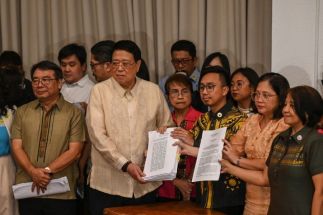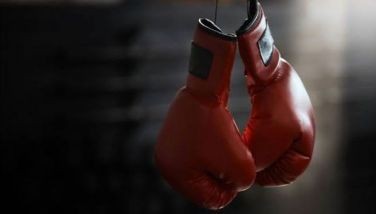Finding Ninoy
August 20, 2003 | 12:00am
By this time, others will have written much about Ninoy Aquino, as our hero deserves. It is The Greatest Story Ever Retold.
And, against the grim and ludicrous backdrop of these confusing times, with so much disparaging and discouraging talk in the air, rumors of once and future coups spiced up with paranoia and embroidered with silly allegations of assassination "plots", we have need of being reminded that this disappointed nation once produced a man who was constant and brave.
Ninoy was a lodestar, pointing to our true heart. He said when he came home to face the destiny of his death that "the Filipino is worth dying for". Remembering him today is a challenge to ourselves to demonstrate that worth.
The present movie hit in many countries is about a fish. I’ve watched it and enjoyed it immensely.
It’s a Walt Disney cartoon about – would you believe? – courage, persistence, and love. No, I’m not into my second childhood, although my age so warrants, yet Finding Nemo, that animated saga, touched most of its viewers halfway between laughter and tears.
Finding Ninoy is more complicated, but the search, in itself, is more rewarding. For it enables us to recapture what we used to be as a people, and what we can be again.
If you ask me, one of the best books about Ninoy Aquino will never be read by us Filipinos. Because it was written in Japanese (Nihongo) and never translated into English. It never will be, I think, because for its Japanese publisher it was penned in the heat of more immediate memory and emotion, and you know how they are in the realm of manga (comics) where there’s a new technological and computerized geegaw unveiled every week in Tokyo’s Akihabara, even a Dick Tracy-type wrist cellphone. What was "new" last month becomes swiftly "old", and is speedily discarded.
Yet, I recall it well. The dramatic book about Ninoy Aquino, written by one of the journalists and friends who had accompanied him on that fatal plane ride to Manila on August 21, 1983, was already a bestseller among Japanese readers when I arrived in Tokyo in April, 1985. It had been penned by Kiyoshi Wakamiya, and within four months had already sold more than 300,000 copies, a phenomenon which already put it into the Top Ten.
The only book which was marginally outselling The Aquino Story was the Japanese-translation of the autobiography of Chrysler Corp. wizard Lee Iacocca, nosing it out by less than 50,000 copies. Why was Iacocca’s story so popular in Japan? To Japan’s powerful automotive industry and the workaholic nation dubbed in those halcyon days "Japan, Inc.", the energetic, tough-talking Lee Iacocca represented the American Challenge. Who remembers Iacocca, even in America, today? Indeed, who remembers in Japan somewhat diminished by the aging of its population the disappearance of its "job for life" guarantees, the bankruptcy of its banking system, the loss of Pebble Beach, California and other mundane factors those powerhouse days of "Japan, Inc."? Is the only passion remaining over there the passion for Louis Vuitton and Prada?
Japanese reverence for Ninoy was based on a rather different premise from that of Iacocca. In his book, Wakamiya not merely described Ninoy’s death on the tarmac, but went back to his life, his warm relationships with friends and family members, his letters and poems. Some Japanese friends in Tokyo and Osaka told me during that "bestseller" period how Wakamiya’s affectionate tome had brought Ninoy "to life" for them, making Japanese understand him, making them appreciate his dedication to liberty, and, most of all, his courage up to the closing moments of his life.
I was told that within less of an hour of Ninoy’s airport murder, the news was being broadcast all over Japan. That evening, all television viewers saw that gripping film sequence of Ninoy, smiling and looking so charming and vital on the airplane just as his "China Airlines" aircraft approached Manila. The televiewers heard his quips and remarks, saw him in prayer – and, finally, that tragic denouément when the soldiers arrived to arrest him. He smiles up at them, but, as he rises, his face grows grim. To Japanese, this scene represented an acceptance on his part of impending death.
In the Japanese language, Aquino ("akino") means "autumn field". The TV cameramen and newsmen who accompanied Ninoy on that last leg, the flight from Taipei, saw a brave man preparing himself for death. He laughed, told a few jokes, cheerfully gave interviews, made his peace with God in prayer. Among a people with a samurai tradition, and who admire bravery, Ninoy Aquino’s story will never grow cold.
In our own land, may the warmth and value of that story be enhanced by its retelling.
"Matakot sa kasaysayan pagkat walang lihim na di nahahayag" (Fear history, for it respects no secrets). These was the warning voiced by Gregoria de Jesus, the widow of the "executed" (murdered) Andres Bonifacio – who was condemned to death by the Magdalo group, incidentally, of the Katipunan. The hero’s widow penned these words in her final testament issued, in Kalookan, on November 5, 1928. (She had continued her husband’s Revolutionary fight, and later married Juan Nakpil, commander of the Revolutionary Troops of the North.
Ninoy Aquino had no secrets. He let it all hang out.
When he was assassinated at the airport there was an upsurge of anger throughout the country and three million defying the dictator Ferdinand E. Marcos marched at his funeral – our own Long March which covered many kilometers and lasted from early afternoon to the darkness of night. Yellow ribbons were everywhere, and on every lip, as well as tagged on every breast, was the slogan, "Hindi ka nag-iisa!" (You are not alone!).
Does anything last in the Philippines? On April 20, 1985, the Asian Wall Street Journal ran a headline saying: Aquino Revolution Fades with Apathy. The critical subhead added: Filipino Public Protests Dwindle, and Trumpeted Trial Draws Few.
The piece had been written by Tony Spaeth, a journeyman journalist who usually did his homework (and whose articles you’ve recently been reading in Time magazine). Tony pointed out that, from what he observed the yellow ribbons, the Hindi Ka Nag-iisa tags and stickers, and the ‘I Love Ninoy’ decals, had disappeared. The ranks of demonstrations had dwindled.
In reply, on April 25, I wrote in Mr. & Ms. magazine, a weekly published, mind you, under the frowning threat of the Marcos hegemony, that "Ninoy Aquino will never be forgotten, his ‘revolution’ will never fade, for he gave us back our pride. And the once monolithic and seemingly invincible Marcos regime will never be the same again."
"Ninoy showed us that one brave man can turn the tide. And that courage, like cowardice, is contagious. Let us ask no more of him. Mr. Marcos and his cohorts have performed a useful function. They have held a mirror up to our faces and showed us what kind of people we are. As our hero Dr. Jose Rizal put it so bluntly and so well: ‘Tal pueblo, tal gobierno’." (As the people are, so is their government).
In those days, journalists and writers who defied the Marcos tyranny were scornfully called by Malacañang "The Mosquito Press". We had to remind them that a mosquito sting can kill (a touch of defiant braggadocio there). As a former cellmate of Ninoy in prison, I guess, I enjoyed some sort of pseudo-immunity from arrest. Picking me up again might prove too scandalous. Yet, none of us had any illusions. We always, especially after we launched the Philippine Daily Inquirer in 1985 to fight Marcos on a daily basis (I was its founding Publisher cum columnist), kept a small bag packed – with a mosquito net tied to it – so we would have some "necessities" if we were suddenly arrested by Macoy’s military goons. That was the optimistic view. I subsequently found that my name had been included in "Oplan Mad Dog", a list of persons to be picked up and executed.
That’s all water under the bridge. We won the fight. Contrary to Tony Spaeth’s dire observations, the Ninoy Magic had never evaporated, and his name proved the battlecry which was to rally People Power to the EDSA, barricades in February 1986.
On that fateful August 21, 1983, from Ninoy’s bloodstained shirt on the Manila airport tarmac had been recovered the "arrival statement" which he never got to deliver. In it were the lines: "According to (India’s Mahatma) Gandhi, the willing sacrifice of the innocent is the most powerful answer to insolent tyranny that has yet been conceived by God and man."
How true and prescient that quotation was!
I conclude this little piece with two quotations of my own, culled from two of my favorite writers.
The first is derived from Han Suyin, and is contained in the last chapter of A Many Splendored Thing (1952), later made into a movie starring William Holden and Jennifer Jones. Wrote Han Suyin: "Afterwards, as happens when a man is safely dead, they spoke of his courage, his nobility; how he walked through the bullets of war for an afternoon amble, and his name was a legend for bravery. They said how cool and even tempered he was, and how his presence quickened those that were with him. They spoke of his gentleness, his tolerance and his understanding. They deplored the fate that had wasted his gifts when they were so much needed."
The second comes from the novel, Man on Fire (1980) by A.J. Quinnell:
"You will make a hero of him," Gravelli warned.
"Then he’ll be a dead hero," snapped Cantarella, "And the dead are soon forgotten."
Ninoy will never be forgotten. He lives.
His death was the spark that brought us back to life.
And, against the grim and ludicrous backdrop of these confusing times, with so much disparaging and discouraging talk in the air, rumors of once and future coups spiced up with paranoia and embroidered with silly allegations of assassination "plots", we have need of being reminded that this disappointed nation once produced a man who was constant and brave.
Ninoy was a lodestar, pointing to our true heart. He said when he came home to face the destiny of his death that "the Filipino is worth dying for". Remembering him today is a challenge to ourselves to demonstrate that worth.
The present movie hit in many countries is about a fish. I’ve watched it and enjoyed it immensely.
It’s a Walt Disney cartoon about – would you believe? – courage, persistence, and love. No, I’m not into my second childhood, although my age so warrants, yet Finding Nemo, that animated saga, touched most of its viewers halfway between laughter and tears.
Finding Ninoy is more complicated, but the search, in itself, is more rewarding. For it enables us to recapture what we used to be as a people, and what we can be again.
If you ask me, one of the best books about Ninoy Aquino will never be read by us Filipinos. Because it was written in Japanese (Nihongo) and never translated into English. It never will be, I think, because for its Japanese publisher it was penned in the heat of more immediate memory and emotion, and you know how they are in the realm of manga (comics) where there’s a new technological and computerized geegaw unveiled every week in Tokyo’s Akihabara, even a Dick Tracy-type wrist cellphone. What was "new" last month becomes swiftly "old", and is speedily discarded.
Yet, I recall it well. The dramatic book about Ninoy Aquino, written by one of the journalists and friends who had accompanied him on that fatal plane ride to Manila on August 21, 1983, was already a bestseller among Japanese readers when I arrived in Tokyo in April, 1985. It had been penned by Kiyoshi Wakamiya, and within four months had already sold more than 300,000 copies, a phenomenon which already put it into the Top Ten.
The only book which was marginally outselling The Aquino Story was the Japanese-translation of the autobiography of Chrysler Corp. wizard Lee Iacocca, nosing it out by less than 50,000 copies. Why was Iacocca’s story so popular in Japan? To Japan’s powerful automotive industry and the workaholic nation dubbed in those halcyon days "Japan, Inc.", the energetic, tough-talking Lee Iacocca represented the American Challenge. Who remembers Iacocca, even in America, today? Indeed, who remembers in Japan somewhat diminished by the aging of its population the disappearance of its "job for life" guarantees, the bankruptcy of its banking system, the loss of Pebble Beach, California and other mundane factors those powerhouse days of "Japan, Inc."? Is the only passion remaining over there the passion for Louis Vuitton and Prada?
Japanese reverence for Ninoy was based on a rather different premise from that of Iacocca. In his book, Wakamiya not merely described Ninoy’s death on the tarmac, but went back to his life, his warm relationships with friends and family members, his letters and poems. Some Japanese friends in Tokyo and Osaka told me during that "bestseller" period how Wakamiya’s affectionate tome had brought Ninoy "to life" for them, making Japanese understand him, making them appreciate his dedication to liberty, and, most of all, his courage up to the closing moments of his life.
I was told that within less of an hour of Ninoy’s airport murder, the news was being broadcast all over Japan. That evening, all television viewers saw that gripping film sequence of Ninoy, smiling and looking so charming and vital on the airplane just as his "China Airlines" aircraft approached Manila. The televiewers heard his quips and remarks, saw him in prayer – and, finally, that tragic denouément when the soldiers arrived to arrest him. He smiles up at them, but, as he rises, his face grows grim. To Japanese, this scene represented an acceptance on his part of impending death.
In the Japanese language, Aquino ("akino") means "autumn field". The TV cameramen and newsmen who accompanied Ninoy on that last leg, the flight from Taipei, saw a brave man preparing himself for death. He laughed, told a few jokes, cheerfully gave interviews, made his peace with God in prayer. Among a people with a samurai tradition, and who admire bravery, Ninoy Aquino’s story will never grow cold.
In our own land, may the warmth and value of that story be enhanced by its retelling.
Ninoy Aquino had no secrets. He let it all hang out.
When he was assassinated at the airport there was an upsurge of anger throughout the country and three million defying the dictator Ferdinand E. Marcos marched at his funeral – our own Long March which covered many kilometers and lasted from early afternoon to the darkness of night. Yellow ribbons were everywhere, and on every lip, as well as tagged on every breast, was the slogan, "Hindi ka nag-iisa!" (You are not alone!).
Does anything last in the Philippines? On April 20, 1985, the Asian Wall Street Journal ran a headline saying: Aquino Revolution Fades with Apathy. The critical subhead added: Filipino Public Protests Dwindle, and Trumpeted Trial Draws Few.
The piece had been written by Tony Spaeth, a journeyman journalist who usually did his homework (and whose articles you’ve recently been reading in Time magazine). Tony pointed out that, from what he observed the yellow ribbons, the Hindi Ka Nag-iisa tags and stickers, and the ‘I Love Ninoy’ decals, had disappeared. The ranks of demonstrations had dwindled.
In reply, on April 25, I wrote in Mr. & Ms. magazine, a weekly published, mind you, under the frowning threat of the Marcos hegemony, that "Ninoy Aquino will never be forgotten, his ‘revolution’ will never fade, for he gave us back our pride. And the once monolithic and seemingly invincible Marcos regime will never be the same again."
"Ninoy showed us that one brave man can turn the tide. And that courage, like cowardice, is contagious. Let us ask no more of him. Mr. Marcos and his cohorts have performed a useful function. They have held a mirror up to our faces and showed us what kind of people we are. As our hero Dr. Jose Rizal put it so bluntly and so well: ‘Tal pueblo, tal gobierno’." (As the people are, so is their government).
In those days, journalists and writers who defied the Marcos tyranny were scornfully called by Malacañang "The Mosquito Press". We had to remind them that a mosquito sting can kill (a touch of defiant braggadocio there). As a former cellmate of Ninoy in prison, I guess, I enjoyed some sort of pseudo-immunity from arrest. Picking me up again might prove too scandalous. Yet, none of us had any illusions. We always, especially after we launched the Philippine Daily Inquirer in 1985 to fight Marcos on a daily basis (I was its founding Publisher cum columnist), kept a small bag packed – with a mosquito net tied to it – so we would have some "necessities" if we were suddenly arrested by Macoy’s military goons. That was the optimistic view. I subsequently found that my name had been included in "Oplan Mad Dog", a list of persons to be picked up and executed.
That’s all water under the bridge. We won the fight. Contrary to Tony Spaeth’s dire observations, the Ninoy Magic had never evaporated, and his name proved the battlecry which was to rally People Power to the EDSA, barricades in February 1986.
On that fateful August 21, 1983, from Ninoy’s bloodstained shirt on the Manila airport tarmac had been recovered the "arrival statement" which he never got to deliver. In it were the lines: "According to (India’s Mahatma) Gandhi, the willing sacrifice of the innocent is the most powerful answer to insolent tyranny that has yet been conceived by God and man."
How true and prescient that quotation was!
I conclude this little piece with two quotations of my own, culled from two of my favorite writers.
The first is derived from Han Suyin, and is contained in the last chapter of A Many Splendored Thing (1952), later made into a movie starring William Holden and Jennifer Jones. Wrote Han Suyin: "Afterwards, as happens when a man is safely dead, they spoke of his courage, his nobility; how he walked through the bullets of war for an afternoon amble, and his name was a legend for bravery. They said how cool and even tempered he was, and how his presence quickened those that were with him. They spoke of his gentleness, his tolerance and his understanding. They deplored the fate that had wasted his gifts when they were so much needed."
The second comes from the novel, Man on Fire (1980) by A.J. Quinnell:
"You will make a hero of him," Gravelli warned.
"Then he’ll be a dead hero," snapped Cantarella, "And the dead are soon forgotten."
Ninoy will never be forgotten. He lives.
His death was the spark that brought us back to life.
BrandSpace Articles
<
>
- Latest
- Trending
Trending
Latest
Recommended




























